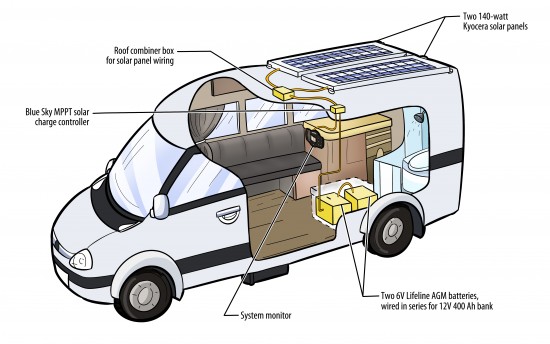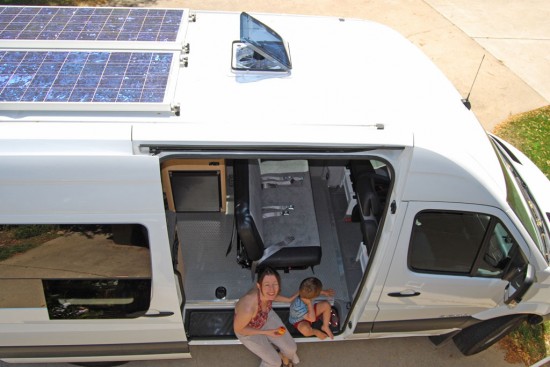RV Solar Systems
If you’re an RVer who likes to “boondock”, meaning camping in places without electrical plug-ins, generating your own power is necessary. You can create your own electric power using:
- a generator – which is heavy to carry in your RV, bulky, and noisy
- fuel cells – direct-methanol fuel cells like EFOY fuel cells are used on many RVs in Europe, but in North America they are expensive and largely untried systems, and the methanol fuel cartridges they use are expensive and hard to find
- solar panels – which generate power silently, and are now very cheap compared to a decade ago, though they won’t generate power in the night or if they’re shaded.
I think it’s a logical and easy step to have an RV solar power system, even on a smaller RV like a Mercedes Sprinter van. Nowadays, high-quality solar photovoltaic (PV) panels can be bought from North American stores like the Home Depot, Lowe’s and CostCo.
RV Solar Systems – Advantages and Drawbacks
An RV solar system can provide ALL the power you need while camping, without needing a generator, if you’ve designed your electrical system efficiently and have a good solar setup and good sun. But is an RV solar system right for you? Depends on several factors:
- Do you camp in RV parks and campgrounds with electrical hookups? If most of your RVing is in places with easy access to electric power, you don’t need a system like this. Use the plug-in at your campsite for power from a 30A or 50A “shore power” pedestal.
- Do you need a rooftop air conditioner (A/C) system, or absolutely must have a large microwave? If you want A/C and/or a large microwave, you’re really going to need many solar panels and lots of battery storage. You’re better off plugging into shore power or using a generator, if you really need these things when you’re out camping. If you want a fairly cheap, simple RV solar system, then the more you can save power on your RV (for example, changing all your interior lights to LED lights will shave off 80% of your lighting power use), the cheaper your system will be.
- Do you always camp in shaded areas? Your solar panels need sunlight, good direct sunlight with no shading. Sometimes, slightly hazy days will generate even more power from a solar system than a clear day, because of what’s called “edge-of-cloud” effect, but in most cases you want lots of direct sunlight hours to make the best use of a solar system.
- Do you camp in remote places most of the time? If so, an RV solar system might be a good choice for you, provided your electric power needs are not excessive. You’ll also want to have some roof space on your RV, some RV roofs are cluttered with exhaust vents, stacks, antenna, etc., which makes placing solar panels difficult.
RV Solar System – Calculations
To calculate what size of solar system you’ll need for your RV, you first need to do an electrical load analysis, meaning you’re going to add up the power usage of every appliance in your RV that uses power. There are many online calculators available to help you size a small off-grid solar system like an RV solar setup, but you’ll still need to check the manuals for your appliances to find the exact power draw of each appliance (in watts or amps, and you can use Ohm’s Law to calculate the load in amps). Twelve-volt battery sizes are often given in amp-hours (Ah), so you can calculate how much power everything uses in DC amperes. Here’s an example of the loads in my Sprinter camper van on my 12V DC electrical system:
| Novakool R3800 12VDC refrigerator | Max 2.2A |
| Flojet 4405 water pump | Max 3.9A |
| 8 12-LED interior lights, .2A each | Max 1.6A |
| 2 5-foot LED flexible light strips, .067A per foot | Max .8A |
| FantasticFan 6600R powered vent | Max 1.9A |
| Samlex 150W inverter | Max 12.5A |
| Total RV Electrical Loads: | 22.9A (DC) |
Once you’ve calculated the loads, you’ll need to think of:
- How many days do you need to go without power?
- What temperatures will you be camping at?
- What type of batteries will you use to store power?
- How many solar panels can fit on the roof of my RV?
These questions will help you size your battery bank. There are online battery bank sizing calculators to help you, and a handy rule of thumb some people use is having one amp-hour of power storage for each watt of solar panel capacity.
RV Solar System – Components
A typical RV solar system uses the following components:
- Solar Panels – Solar panels for RVs should be good-quality monocrystalline/polycrystalline panels (not amorphous types, which degrade and have very poor efficiency ratings), UL-listed, warrantied for RV use, and fit the dimensions of your RV’s roof. On my DIY Sprinter RV conversion, I’ve mounted a pair of Grape Solar 160W solar panels, purchased from Costco for US$230 each. Just a few years ago, these panels would have cost US$500 each, and only be available from specialty solar companies. I wired the two “12V” solar panels in series for a higher voltage and current output (for example with two Kyocera KD140SX solar panels, around 36V and 15A of possible maximum power output) to use this with an MPPT charge controller. There’s a detailed buyer’s guide for RV solar panels in my Sprinter RV Conversion Sourcebook.
- Charge Controller – A solar charge controller, designed specifically to take input from solar panels and charge a set of batteries with this energy. Most modern solar charge controllers will offer 3- or 4-stage battery charging, which can be customized for the type (AGM, lead-acid, gel-cell, etc.) and model of battery you’re using for your RV house batteries. Some solar charge controllers also include Maximum Power Point Tracking (MPPT), which (if you use large enough wire on your PV-to-controller and controller-to-battery runs, and have your solar panels wired in series for higher voltage) can provide up to a 10% boost in the power available over a conventional non-MPPT controller. For example, the Blue Sky 2512ix-HV solar charge controller offers MPPT, plus a useful auxiliary charging circuit to charge your RV’s engine battery as well, an uncommon feature on any solar charge controller. MorningStar also offers excellent solar charge controllers suitable for an RV.
- Roof Combiner Box (optional) – A weatherproof RV roof combiner box (like the small C-box from AM Solar) has two purposes: a) it protects the holes drilled into your RV’s roof for the wiring drop from leakage and b) it provides a convenient junction for wiring from your solar array, especially useful if you are planning to use more than two solar panels on your RV’s roof. The drawing shows the combiner box on the roof by itself, but in reality, the combiner box is installed under the solar panels for extra protection and a clean install.
- System Monitor – Many RV solar kits leave out one of the most essential pieces of any RV solar system, a system monitor. A good system monitor can tell you the power output of the solar panels, the state of charge (SOC) of your house batteries, maybe the SOC of your engine battery, and possibly even data on the current battery charging mode being used by the controller and statistical data. I’m using a TriMetric 2025RV system monitor in my Sprinter RV conversion, a popular and full-featured monitor. Without a system monitor, you can’t tell how well your system is performing, and how well your batteries are being charged.
- Battery bank – All RVs already have a battery bank, also known as an RV or house battery bank. I’m using two Concorde LifeLine 6V absorbed-glass mat (AGM) batteries in my Sprinter camper for a 400 amp-hour (Ah) battery bank, which should give me several days of power even if the sun isn’t shining or the RV isn’t moving (I can also charge the RV house batteries using the van’s stock 220A alternator). Compared to typical flooded lead-acid deep-cycle batteries, they are more expensive, but they are sealed and don’t off-gas (an important feature for RV batteries, especially if they’ll be in the cabin), don’t require checking voltage with a hygrometer or periodic watering, and the 6-volt versions have thicker plates than many 12-volt deep-cycle batteries, which means (as long as they’re charged correctly!) they may last longer. They also accept charging at a higher rate than many typical flooded lead-acid batteries.
RV Solar System – Cost
How much does an RV solar system cost? You can go cheaper or pricier, but my emphasis was on a simple, but high-quality RV solar system that would perform well and last a long time (no flexible panels, poor-quality charge controllers or non-bulletproof batteries). Here’s details of the cost of my DIY RV solar system (assembled in 2013):
| 2 160W Grape Solar GS160 solar panels @ US$230 each | US$460 |
| 1 RV roof combiner box | US$80 |
| 1 Blue Sky 2512ix-HV solar charge controller | US$205 |
| 1 TriMetric 2025RV solar system monitor | US$160 |
| 2 6V Concorde Lifeline GPL-L16T 400Ah batteries @ US$600 each | US$1200 |
| Wiring (stranded THHN wire, exterior UV-rated tray cable) | US$100 |
| Installation: DIY installation, supervised by electrician | (free) |
| Total 320W RV Solar System Cost: | US$2250, including batteries |
ASKING YOUR FEEDBACK: Do you find this article useful? Please like it and share it with friends, and anyone who’s interested in RV solar systems! I’ll expand this page further, and you can also find several chapters of details about RV solar systems in my Sprinter RV Conversion Sourcebook.





